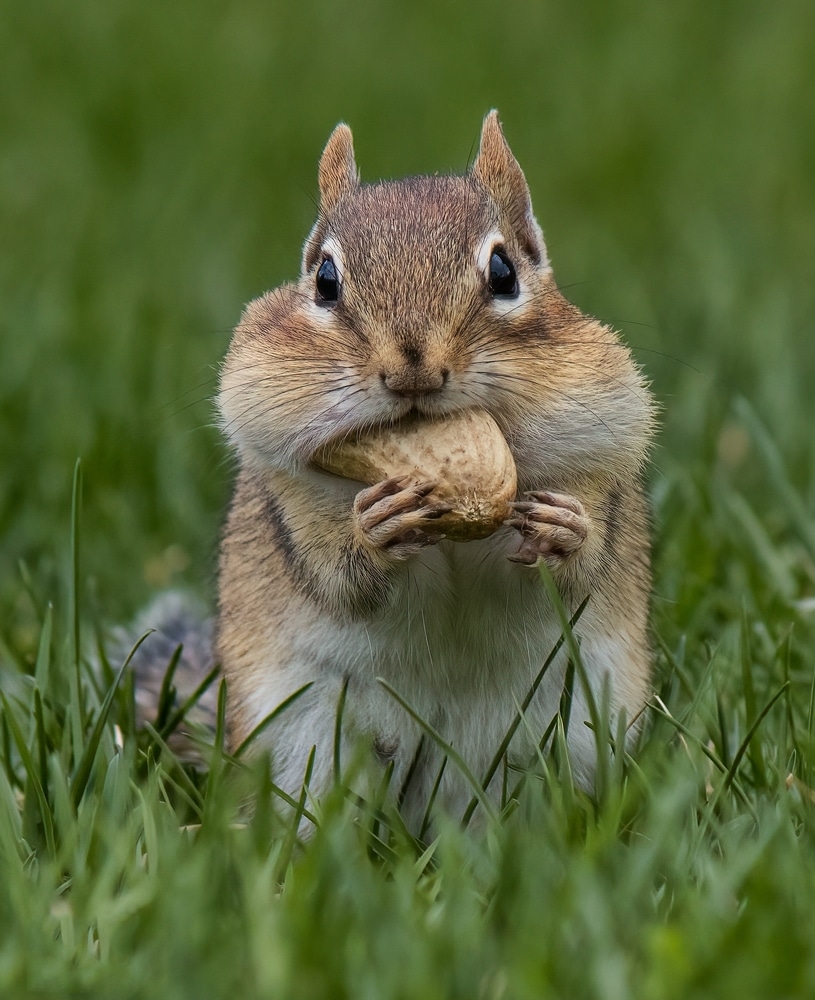Chipmunks are a well-known and loved variety of small rodents, but have you ever thought about how they live? We often see them in the garden, understanding their lives, behaviors, and diet can help us gardeners happily coexist with them.
Hiking through the hills of Wyoming this past fall, I often noticed chipmunks darting from log to log, zooming through the underbrush. Their tails swished in the air, making cute calls when they saw me walking by. I imagined them frolicking and playing together under leaves and logs, rolling and tumbling around the base of trees. It made me wonder: “How well do we know the chipmunk?”
Well, this article answers that question by offering insight into understanding chipmunks in your garden, including their habitat, behavior, diet and tips for how to live well with this cute little animal!
What Is A Chipmunk?
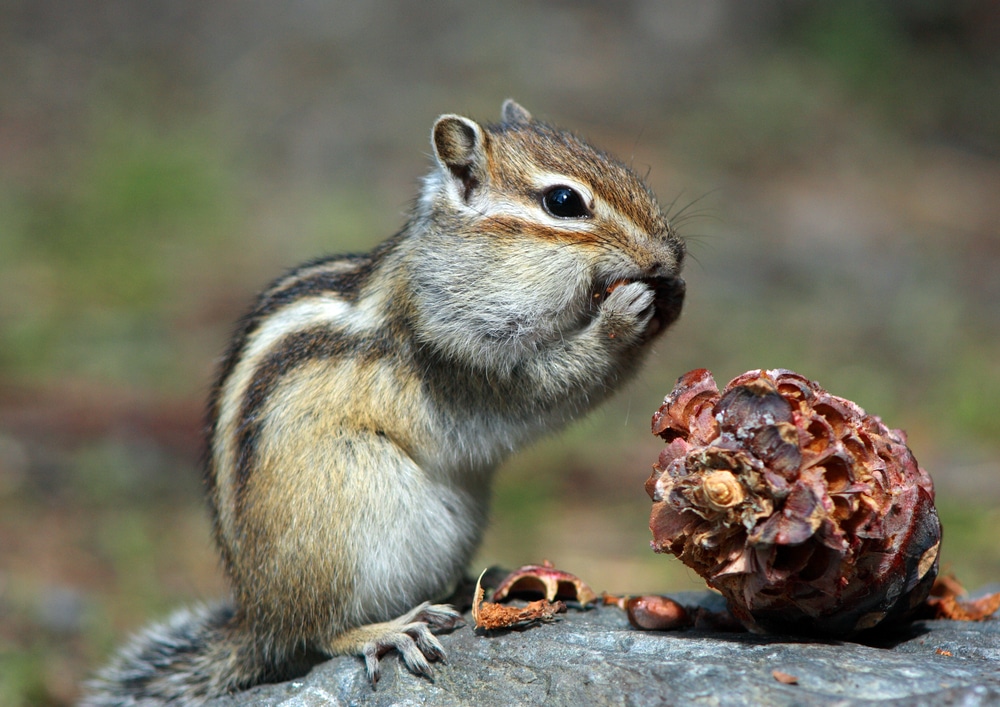
Chipmunk are part of the squirrel family Sciuridae. The name chipmunk originates from an Indigenous Ojibwe word jidmoonh (or “chitmunk”), which translates to the red squirrel. Chipmunks are native to North America and Asia. Asia only has one species of chipmunk, the Siberian chipmunk. However, a massive 23 different species of chipmunk reside in North America!
Chipmunk Behavior And Life Cycle

Chipmunks live a solitary existence, only meeting to mate. During the breeding season, they are polygamous. Mating occurs in early spring through early summer.
A female chipmunk undergoes a gestation period of 21 days before giving birth to approximately 2-5 young. The young then spend around six weeks in the burrow with mum. They become independent after about eight weeks of age.
Chipmunks are diurnal creatures. This means they are awake and foraging during the daylight hours. They spend their evenings and nights in their burrows, sleeping up to 15 hours. In fact, chipmunks spend most of their time inactive!
Do Chipmunks Hibernate?
Eastern chipmunks do hibernate, but it is not a true hibernation as they wake up intermittently. They are unable to store enough reserves to see them through a full hibernation. They store food in the burrow and feed off this cache when they wake up throughout their hibernation.
The western species of chipmunks does not hibernate. This species also lives off food storages they collected in the fall, to make the winter season more manageable.
How Long Do Chipmunks Live?
Chipmunks live a short life in the wild. They typically live an average of 3 years. This shorter lifespan is generally due to:
- Predators
- Human disturbance
- Weather
In captivity, chipmunks can live up to 9 years. This is significantly longer because there is no threat of predators, they have abundant food source, and they are sheltered from all types of weather.
Chipmunk Habitat
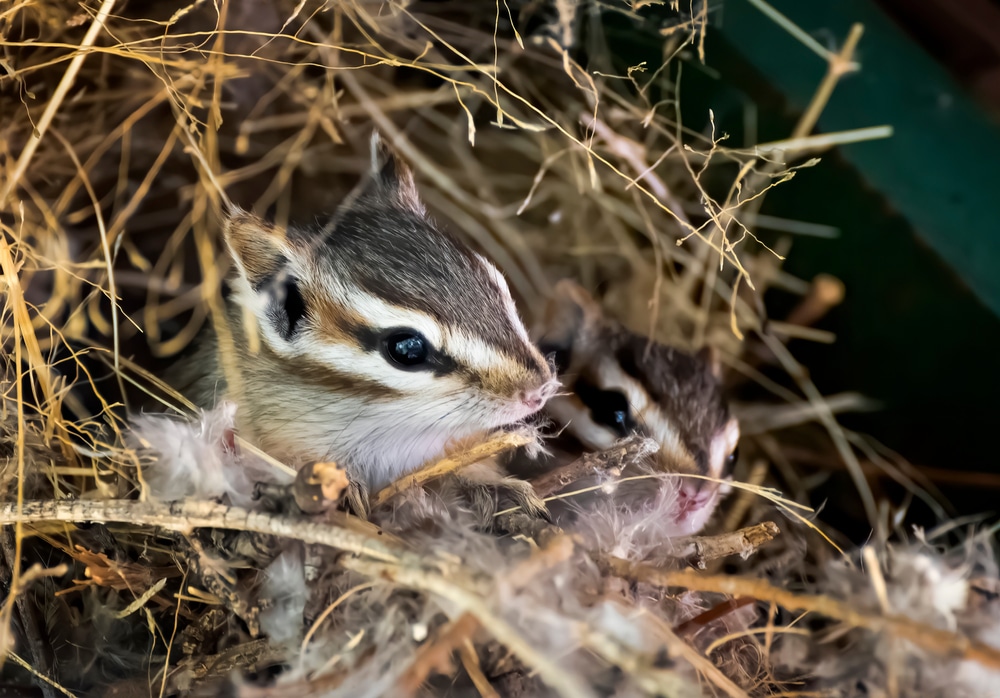
Do Chipmunks Live Underground?
Yes! Chipmunks are ground-dwelling mammals. They spend their time creating an extensive underground system of burrows. These burrows can be up to 11 ft long! The tunnels are organized and clean like a well-organized house. The latrine in one area, the cache of food in another, and both are separate from nesting quarters.
Habitat Characteristics
A chipmunk’s main habitat is deciduous woodlands with a habitat range averages from 0.5 to 1.0 acre. Although they can be found in many different types of habitats, including meadows, they specifically thrive in forest edges or areas with heavy brush.
In areas with high anthropogenic disturbance, chipmunks can be found in backyard gardens. Common areas for chipmunks to frequent are bird feeders and nut-producing trees. They also create their burrowing systems in gardens with lots of shrubs or sheds. These provide them with good hiding spots, as they like to have many concealed entrances to their burrows. They can be found in leaf litter or in areas with little traffic.
The Role Of Chipmunks In The Ecosystem

Importance Of Chipmunks In Seed Dispersal
Chipmunks contribute to a healthy forest ecosystem because they aid in the dispersal of the seeds of important forest trees, like:
- Maple
- Oak
- Pine
- Beech
They also assist in the dispersal of mushrooms. Some species of chipmunk even transfer spores that aid in the dispersal of truffles.
Importance Of Chipmunks In The Food Chain
In addition to seed and spore dispersal, chipmunks also play an important role as a food source for many other forest-dwelling animals. They are a delicious morsel and an easy meal if caught! Their predators include:
- Hawks
- Owls
- Coyotes
- Racoon
- Foxes
- Weasels
- Snakes
- Bobcat
- Lynx
Chipmunk Diet: What Do Chipmunks Eat?

What Do Chipmunks Like To Eat?
Chipmunks are omnivores, eating both plant and animal matter. They are opportunistic predators, as well as foragers. Their favorite meals include seeds, nuts, fruits, and buds. If the opportunity presented itself they would even eat baby birds!
Here’s some of the things chipmunks like to eat:
| Plant | Animal |
|---|---|
| Seeds | Arthropods |
| Nuts | Insects |
| Fruits | Frogs |
| Buds | Worms |
| Grass | Bird eggs |
| Roots & Shoots | |
| Fungi | |
| Acorns |
Chipmunk Feeding Habits
Starting in the fall, chipmunks stockpile food in preparation for the winter season. Chipmunks have cheek pouches, which allow them to carry larger amounts of food back to their burrow for overwinter storage. They cache food in what is called a larder, which is a part of their intricate tunneling systems. They survive on the stored food through the winter months. It provides them with valuable energy while the weather is cold and food becomes less readily available.
Do Chipmunks Eat Garden Plants?
In cultivated areas, chipmunks will definitely eat garden plants. They are opportunistic feeders after all! What type of garden plants do chipmunks prefer? Chipmunks are especially attracted to:
- Grains
- Fruits
- Veggies
- Nuts
Hazelnuts are one of their favorites but they also like acorns from oak trees.
Chipmunks In Your Garden
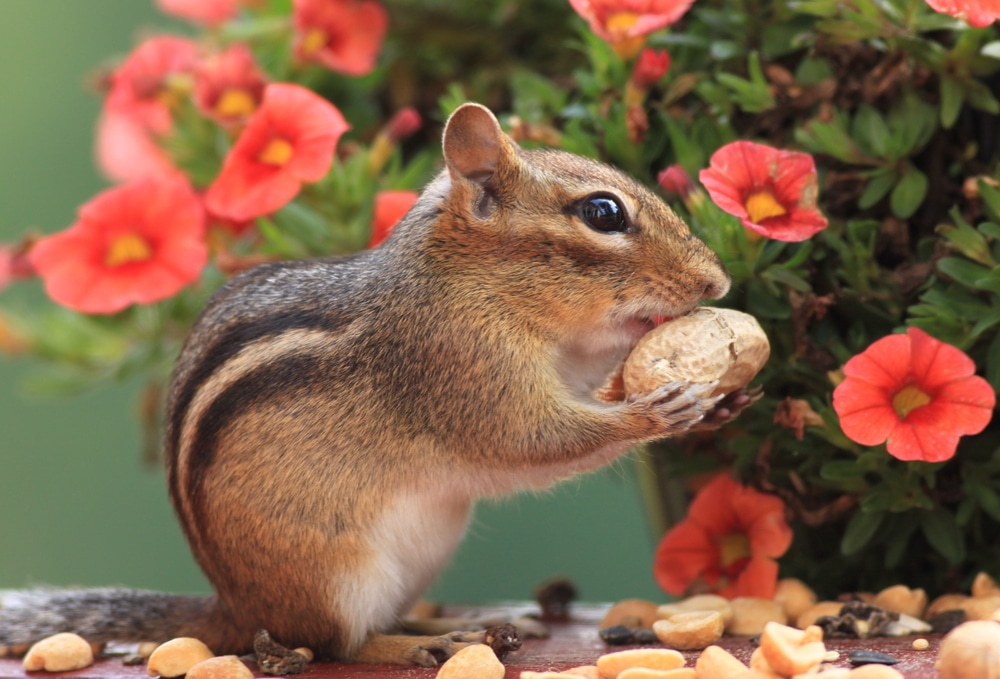
Chipmunks are commonly found in garden spaces. As opportunistic feeders as well as omnivores, gardens offer chipmunks many food sources. This ranges from bird feeders to veggie gardens.
Attracting Chipmunks To Your Garden
Create A Welcoming Habitat
If you are looking to attract chipmunks to your garden and are planting specifically for them, it is important to provide a food source to help them thrive. Choose plants that produce grain, seeds, or nuts. Great choices are:
- Sunflowers
- Hazelnut trees
- Native strawberries
- Wheat
A cute man-made habitat feature is a platform feeder posted up in the fall. Fill it with acorns, nuts and seeds. This allows for quick collection with their chubby cheeks for their winter storage!
Avoiding Potential Garden Damage While Coexisting
Chipmunks are considered a garden pest for two main reasons:
- Burrows: They dig up gardens during their burrow excavation, leaving holes for the many entrances throughout the garden
- Plants: sometimes they help themselves to your garden plants without asking!
There are ways to provide the necessary habitat features to attract chipmunks while maintaining a healthy high-yield garden. Creating a designated garden space for the chipmunks is the first step. If you have veggies and fruits that you don’t want the chippy’s to munch on, try using protective meshing or cages. Below we will go into more natural ways to coexist with chipmunks.
Chipmunks vs. Ground Squirrels: What’s The Difference?
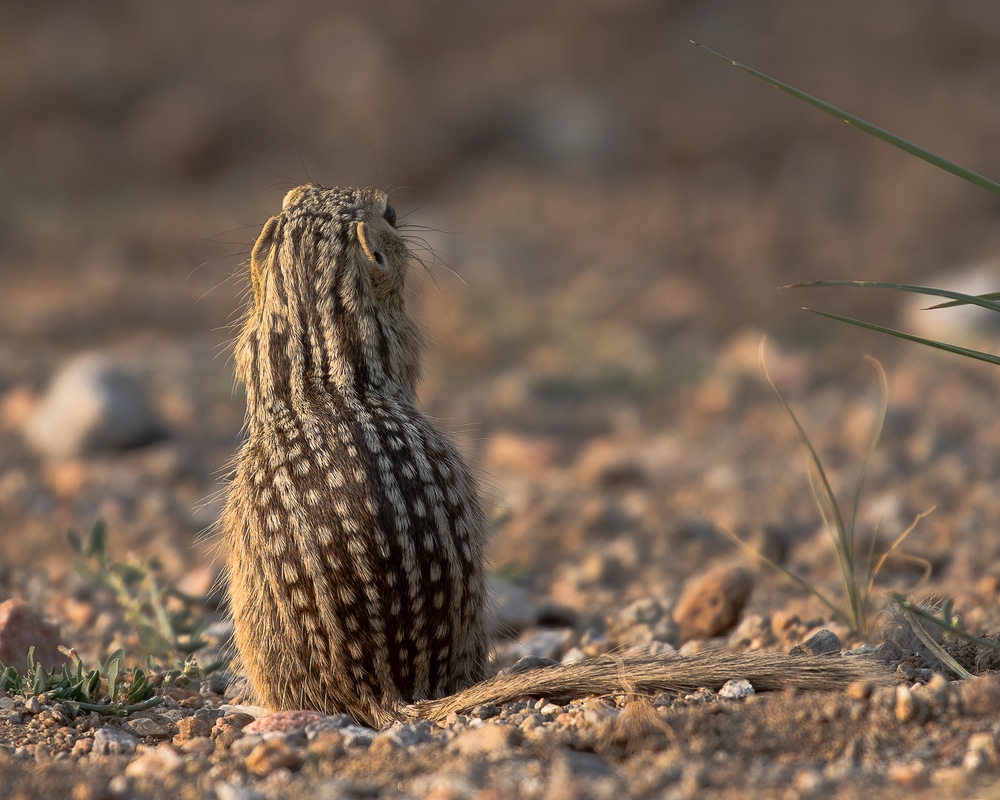
Within the squirrel family (Sciuridae) there are three different subfamilies:
Chipmunks are a species within the subfamily of ground squirrels. There is a wide range of species within this subfamily. From ground squirrels like Columbian ground squirrels to marmots and prairie dogs.
The best way to tell apart these animals is by size and color pattern. Chipmunks are the smallest members of the squirrel family, at around 10 inches (25.4 centimeters) long. Whereas ground squirrels can be up to 12 inches (30.48 centimeters) long.
Some other species of ground squirrels, such as the thirteen-lined ground squirrel, have 13 distinct stripes down their backs. Different species can have a different number of stripes. In general, chipmunks have stripes only on their backs while ground squirrels have them on their backs and heads. By first determining the size, and number of stripes, you can easily identify a chipmunk from a ground squirrel.
Another way to tell them apart is habitat. Ground squirrels tend to like open grassy areas, whereas chipmunks prefer wooded habitats.
Chipmunk Pests: Prevention And Solutions

How To Prevent Chipmunks From Eating Your Plants
Chipmunks are sometimes considered pests due to:
- Burrowing systems
- Digging up the garden for grubs and bulbs
- Holes in the lawn
- Eating garden plants
But the good news is that there are natural ways to prevent chipmunks from invading your space. It’s always important to use non-lethal ways when dealing with these innocent animals on your property. Better yet! Learning to coexist with chipmunks can be the most beneficial for a happy and vital ecosystem.
Here are some natural and humane tips to repel chipmunks from gardens:
Inhibit Access To Bird Feeders
If you notice chipmunks constantly eating at your bird feeders, try adding some deterrents. You can find many different mechanisms that go over the posts of bird feeders. Or you can buy special bird feeders that squirrels, chipmunks, and other rodents can’t access.
Cayenne Pepper
Another way to deter chipmunks from the bird feeders is cayenne pepper. Mix the spice into the bird feed to deter chipmunks and squirrels. Chipmunks don’t like the taste of cayenne and birds aren’t bothered by it.
Enclosed Garden Beds
Enclosed garden beds are an easy solution to separate your fruit and veggies from any animals looking to take a bit. Chicken wire lids can easily be built onto existing raised wooden beds. Simply add a latch and hinges and you’ve got yourself an enclosed bed. For extra protection, add chicken wire to the base of the wooden box before adding soil.
Grow Scented Plants
My favorite way to deter chipmunks is to use scented plants like:
- Mint
- Lavender
- Marigolds
- Scented geraniums
Chipmunks also avoid bulbs like allium and daffodils. Growing these plants throughout the garden acts as a barrier for repelling chipmunks and has the added benefit of giving you something nice to look at!
Important Note: Live traps are not recommended as a humane way to remove chipmunks from the garden. In fact, in many states throughout the US, it is illegal to catch and release chipmunks. Live traps cause chipmunks a lot of stress. This is because introducing chipmunks to a new area can be detrimental to them. They don’t have their burrows for protection and aren’t familiar with the surroundings.
Chipmunk Care and Safety: FAQs
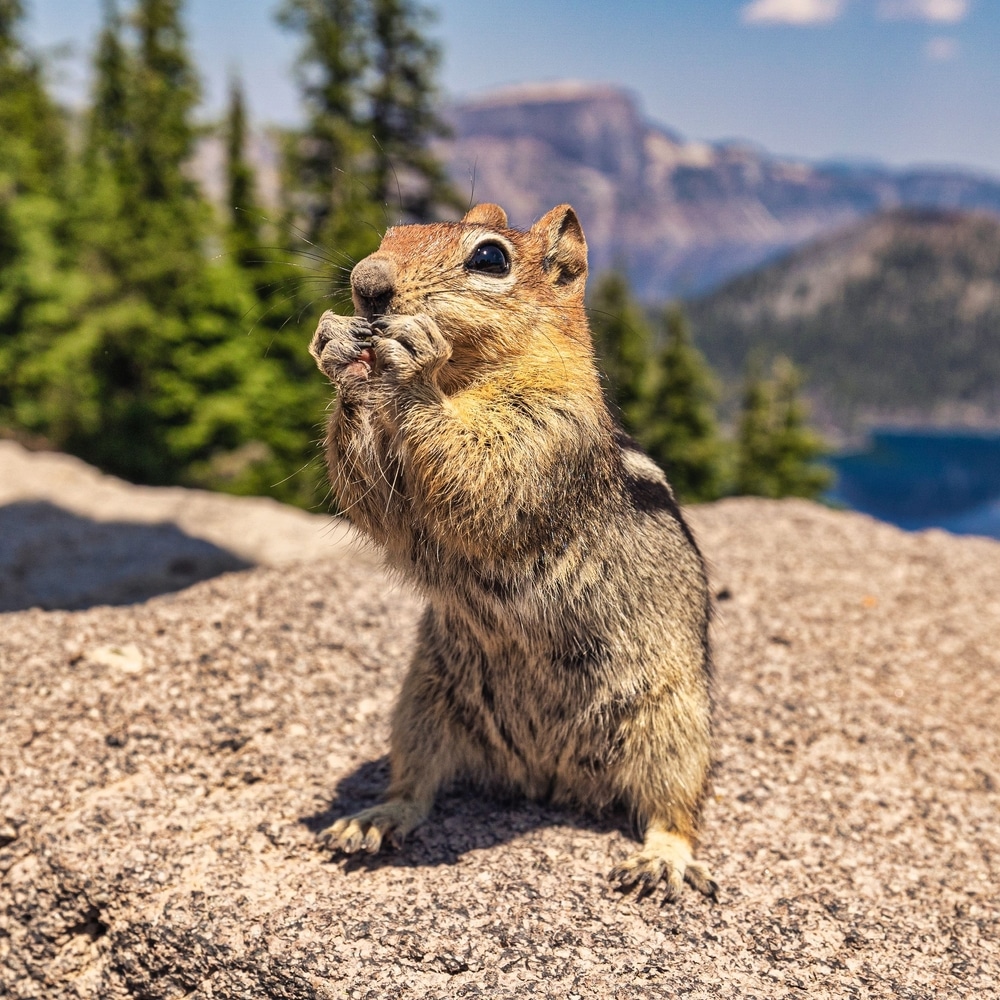
Do Chipmunks Bite?
The best practice is to give chipmunks plenty of space, never try to pick them up. If threatened, handled, or cornered, chipmunks will bite. This is a defense mechanism. They will also use their claws to scratch if they feel threatened.
If you have been bitten by a chipmunk, seek medical attention. It is important to keep the wound clean. Wounds can become infected quite easily, so use antibiotic ointment and visit a professional.
What To Feed Chipmunks?
Chipmunks like a variety of food. Always remember to feed natural, unsalted food. Small portions are better and avoid overfeeding. Some of their favorites include:
- Seeds:
- Sunflower
- Pumpkin
- Nuts:
- Hazelnuts
- Acorns
- Almonds
- Fruits:
- Strawberries
- Raspberries
- Blueberries
- Grains:
- Wheat
- Oats
- Veggies:
- Cucumber
- Peas
- Corn
What Kills Chipmunks?
Chipmunks are an important part of the food chain by being a food source for many predator species. Some of their predators include:
- Hawks
- Owls
- Coyotes
- Racoon
- Foxes
- Weasels
- Snakes
- Bobcat
- Lynx
- Domestic dogs and cats

